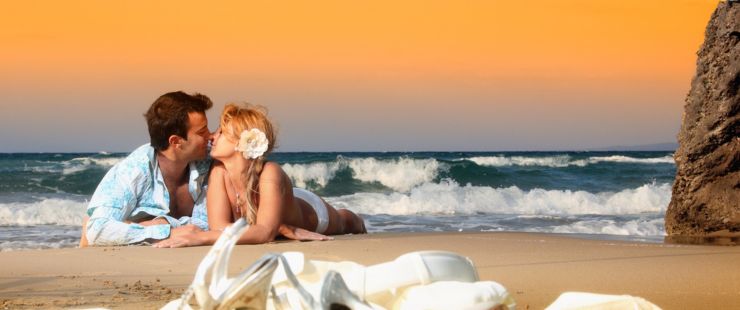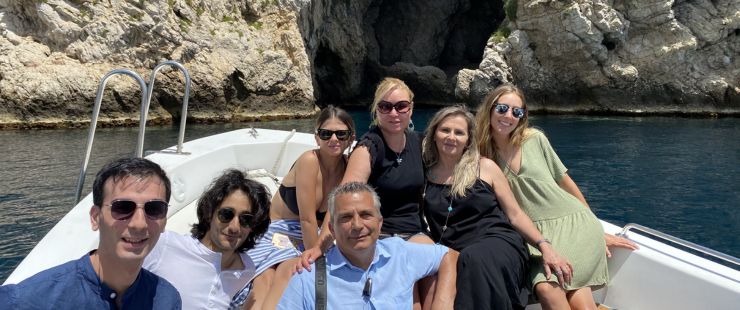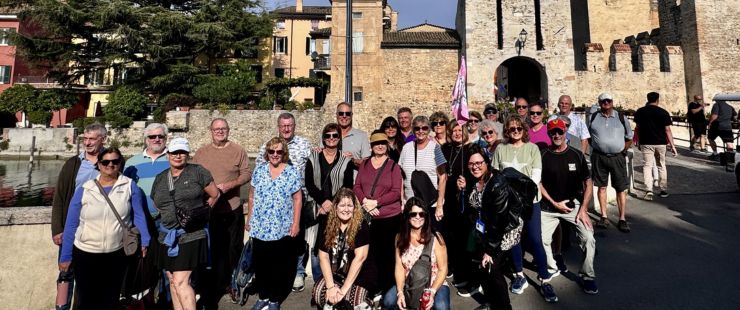Amazing Amalfi - Semi Private Package
-
 Tour Code:
TUR-00281
Tour Code:
TUR-00281
-
 Type:
Semi-Private
Type:
Semi-Private
-
 Duration: 5 days
Duration: 5 days -
 Departs from:
Naples
Departs from:
Naples
-
 Meeting Place:
Rail Station - Airport - Hotel
Meeting Place:
Rail Station - Airport - Hotel
Overview
Our headquarters are situated in Sorrento, which is located on Italy's Amalfi Coast. We have over 20 years of experience in organizing tours, excursions, and weddings in this area of Italy. As experts in this region, we are aware of the hazards, stresses, and difficulties associated with traveling to this magnificent part of Italy. Driving in this area can be complicated, which is why we recommend avoiding it. You can read more about this in our blog, which can be found here. "Places to Avoid Driving in Italy"
Our "Amazing Amalfi package" is a comprehensive package that includes everything you would want to do when visiting the Amalfi Coast. It can be tailored to your preferences and requirements. The package starts from Naples with a private transfer from the railway station, port or airport in Naples to your hotel in Sorrento. If needed, we can also arrange transportation for you from Rome by either train or private transfer.
During the 5-day trip, you will have the opportunity to explore the charming towns and villages along the Amalfi Coast, visit the ancient ruins of Pompeii, wander through the beautiful gardens of Ravello, and marvel at the stunning island of Capri. In this program, most meals are included in authentic, locally-owned restaurants that use the freshest local ingredients. This is a great feature since ordering food in Italy can be challenging and confusing at times. The restaurant staff are knowledgeable about the best local specialties, which are unique to this region of Italy. You will be able to enjoy the freshest picks of the day and savor the delicious flavors that originate from this area.
We work with only the best licensed local guides who can bring the magic and history of incredible destinations to life during our tours. Our package is personalized just for you, so we can include features tailored specifically to your interests.
The accommodation in our package is a delightful four-star hotel located in the heart of Sorrento. We've provided several top choices for you to choose from, all of which offer stunning views and gorgeous accommodations with excellent service.
The beauty of our all-inclusive package is that we take care of everything, from driving to tickets and tours, so you can relax and fully enjoy one of the most beautiful coastal areas on the planet, without any stress.
For more information and to book this tour get in touch with us today! TOLL FREE 1-866-779-2565 Direct in Italy: +39 436 317 9482
 Email: team@italyvacationspecialists.com
Email: team@italyvacationspecialists.com
We respond in 24 hours!
Itinerary

Where we Visit : Naples, Sorrento, | Meeting Location : Rail Station - Airport - Hotel
Dinner in a local trattoria and overnight at the hotel in Sorrento.

Where we Visit : Capri,
After landing on Capri we head up to the top of the island by minibus to Anacapri with stunning views over Capri. This beautiful village, which today is a town in itself, is an integral part of the island. Inhabited since Roman times, as evidenced by the many ruins, Anacapri had its heyday between the nineteenth and twentieth centuries, when it became a coveted "retreat" for artists from across Europe who came here to spend happy holidays and to find inspiration.
In Anacapri you can visit the famous Villa San Michele, which was bought and restored in 1895 by Swedish doctor Axel Munthe, who fell in love with the ruins of an ancient chapel, consisting of a few crumbling walls. While doing restoration work in the adjacent vineyard the remains of an ancient Roman villa came to light, he decorated the new house with numerous archaeological remains that may be observed in the original construction of Munthe. The restoration lasted many years. The story of his life is told in an autobiography, he wanted to call it "The Story of San Michele”, which also contains all phases of the restoration and it was published in 1929, and proved to be one of the most read books in the twentieth century. Upon his death in Rome in 1949, Munthe left the house to the Swedish state. Today it is owned by a Swedish foundation that has transformed it into a museum where, in the summer, beautiful classical music concerts are held. Free time in Anacapri for lunch, and those who want to shop will be spoiled for choice given the wide variety of typical products and clothing etc. .. For nature and landscape lovers there will be a nice opportunity to get the chair lift that arrives at 600 mt. around the summit of Monte Solaro, the highest point of the island. Continue to the famous "Piazzetta" of Capri, meeting place of VIPs and vantage point of great beauty. Then you can have free time for shopping or go for a short walk to the Gardens of Augustus, which are very relaxing, and also have a breathtaking views, after crossing the streets of Capri, full of shops and sparkling windows. The gardens were commissioned in the '30s by the German steel magnate Krupp, who also wanted to achieve, a masterpiece of engineering made of winding roads above the sea, linking the gardens and the Certosa at Marina Piccola .You will return to the port at Marina Grande, time and weather permitting, you can enjoy the beauty of the coast of the island with a boat ride or visit the Blue Grotto which is known throughout the world for its size, and for its intense blue and silvery white water reflecting immerse objects. To enter the Blue Grotto you have to climb in a small rowboat, lying on the bottom, you cross the narrow gap opened in the natural rock. It is impossible to do on days when the wind blows south-west or northwest. The entrance to the Blue Grotto is a small gap in the rock wall, about 2 meters wide and high, which is about 1 meter above sea level. Abandoning the oars the rower pushes the boat into clinging to a side chain on the ceiling of the entrance. The interior is all light blue, once called the Blue Dome, it has an average height from 7 to 14 feet, the erosion of the cavity is about 60 meters long and 25 wide. The cave continues with the Hall of Pillars, three communicating branches that converge in the Hall of Names, so named for the many visitors signatures affixed to the walls, and the Passage of Corrosion, to the last accessible point, the Hall of Corrosion .
The blue colour of the Blue Grotto is due to the fact that daylight enters through an underwater window that appears right under the entrance, thus undergoing a change of colour, which absorbs the red colour and lets blue filter through. It is believed that the interior of the Blue Grotto in Roman times, the time of Tiberius, was used as a marine ninfeo, there have been those who have imagined it as a place where the Nereids or Syrens and those who believed it was the kingdom of devils, intimidating anyone who dared enter. In the afternoon return to the port of Sorrento and subsequent transfer by minibus to your hotel where you can reflect on why Capri is defined as one of the most beautiful islands in the world!!!
Please note that the entrance to the Blue Grotto must be paid in cash.

Where we Visit : Pompeii,
After a journey of about 30 minutes to get to Pompeii. Pompeii was founded around the eighth century BC by Osci who settled and divided it into 5 villages at the southern foot of Mount Vesuvius, not far from the river Sarno, then navigable. The number five, in Oscan, probably derives the name of the town. The first settlements date back to the Iron Age, or the IX - VII century BC C., when there was the culture of "graves".
Pompeii at that time was a very important commercial centre, so that it was a target for expansion by the Greeks and the Etruscans before, the Samnites later. The Samnites had the merit of having enlarged the walls of the town, and giving it a large urban development. At this time there was a strong architecture impulse: a triangular and rectangular Forum were reconstructed and important buildings like the Temple of Jupiter, the Basilica and the House of the Faun, which is the size of a Hellenic Palace. In the same period has also built the Temple of Isis was built and it is clear evidence of trade with the East of Pompeii. Pompeii became the residence of the Roman nobility and, in Imperial times, many families supported Augustus’s policy and moved here and ordering the construction of buildings like the Temple of Fortuna Augusta and the building of Eumachia. Under Nerone the Campania region suffered heavy damage due to an earthquake which occurred in 62 or 63 A.C..
The Roman Senate immediately ordered the reconstruction, but all was in vain, because August 24 of 79 B.C., when rebuilding was still underway, a disastrous eruption of Vesuvius wiped it out completely with, Herculaneum, Stabia and Oplonti. There was almost no escape for anyone and the thriving Pompeii was only a cloak lava often up to three meters and cemented the inhabitants and destroyed all manner of life. From this great tragedy the famous archeological excavations of Pompeii, where began and been brought to light the ancient Roman city destroyed tragically after one of the eruptions of the nearby volcano Vesuvius in the year 79 B.C.. In Pompeii work started around 1748, in the area of Civita, which was then believed to be Stabia, alternating with breaks due to other discoveries at Herculaneum, and continued mostly without a definite plan and without a precise method, performed by prisoners in chain and young boys.
The research was aimed only at finding material for museums or to decorate the royal palaces, while the buildings excavated, once stripped of artworks, were left without any care or protection from the weather. With the outbreak of the France revolution and also the start of the first revolutions in Naples the activity of the excavations decreased significantly with Joseph Bonaparte and Joachim Murat, later resumed, on a larger scale, and more intensively. With the birth of the Kingdom of Italy in 1861, the Savoys did not underestimate the prestige arising from the discovery of Pompeii. By the wish of the new king systematic excavations began: he appointed Giuseppe Fiorelli as director, a professor of archeology at the University of Naples. Fiorelli adopted a scientific method, with logging excavation, surveying, indexing of objects, and employing more than five hundred workers. To him we owe the invention of the method of filling with plaster the gaps left by the victims in bank hardened ash, providing a kind of matrix that produces the imprints of the bodies caught in the moment of death, with dramatic intensity. The system of removing all objects from the excavations was abandoned: the paintings and mosaics were mostly left in place, the houses were covered with carved roofs which copied the layout and provide a hedge against early deterioration. The years that followed were the best: extending the search to the east and towards the Porta di Nola, bought to light many houses, consolidate the structures and restoring the paintings on the site.
The last thirty years have been alternately modest exploration for the conservation, of primary importance to this unique place in the world. The excavation work is overshadowed today by the need to restore and protect this world famous site, the best example of a Roman city in the world. The visitor will realize that Pompeii offers a variety of things to see that the guide will need to select in order to give visitors an idea as complete as possible of the classical Roman city. In fact you can admire all the structures typical of the Roman world as the main square or forum, baths, theaters, the neighborhood of prostitution (brothel), the roads that intersect the second axis east-west and south-north, mansions with remains of frescoes from Roman times, the attraction of spectacular plaster casts containing bones of Pompeians that died during the disaster, numerous shops that lined the streets and the remains of electoral registrations. The excavations of Pompeii, Herculaneum and with those of Oplontis are given in the list of UNESCO World Heritage Site.
Thanks to the scientists, historians, archeologists, restorers and all those people who are so dedicated with the tragedy of Pompeii that did not destroy the city, there have only stopped enough time to return it to the appearance it had on that particular day in 79B.C. After the visit of the excavations free time for lunch and proceed to visit the crater of Mount Vesuvius. This volcano is particularly interesting for its history and the frequency of its eruptions. Is part of the Somma - Vesuvius mountain system, 1281 meters high . It is located slightly inside the gulf coast of Naples. Vesuvius is a sight of unusual beauty in the landscape of the Gulf, especially when viewed from the sea with the city skyline. After the 1944 eruption, Vesuvius is considered dormant. This period of rest is atypical, and the eruptive activity appears severely delayed. For some reason, still mysterious, the duct, virtually always open since 1631, must have been blocked in depth, or should have emptied its "pockets" of magma that fed the cyclic activity, so the volcano apparently inert as it was before 1631. On clear days the most famous volcano in Europe, offers spectacular and striking views, leaving the eye to wonder over the sea, islands and the archeologic excavations of the cities buried by the eruption of 79AC. .
A few years earlier, in 62 AC., a terrible earthquake, premonitory of a far worse catastrophe that would have struck in a few years the cities of Pompeii and Herculaneum and other towns in Campania. Since dawn of that day in 79 AC., on Mount Vesuvius appeared a large cloud. At ten o'clock in the morning the gases that were pressing inside exploded and the solid lava, that blocked the volcano crater, reducing it in to ash and liquid lava. The ash was so thick that it blocked out the sun. Since that terrible day the cities have ceased to exist and remained buried for centuries under a blanket of over 6 meters of ash and lava. With the coach we will reach a height of 1000 meters, then continuing walking along a path and reaching the peak of the volcano, for an impressive view of the crater visited with a specialized mountain guide. Return to Sorrento in the afternoon.

Where we Visit : Amalfi Coast,
The Amalfi Coast is known for its diversity : each of the towns on the coast has its own charm and its traditions. During the first part of the day we will pass, with the coach, the famous and romantic Positano. The origin of the name of Positano is narrowed to two traditions. The historical version that the name derives from Paestum, whose inhabitants took refuge in the area during the raids of pirates. The other version has it that the name comes from a voice that kept saying "... posa posa ...", heard when, during a crossing by sea of a painting of the Madonna, the boat encountered a heavy storm. The men then fled to what is now known as the bay of Positano, and when they laid the picture on the beach, the storm stopped. The origins of Positano are lost in the mists of time, where history and legend mingle.
As often happened in the past, the myth, which replaced the lack of clear data, tells us that Positano was founded by Poseidon, the god of the sea, for the love of the nymph Pasitea. At the time of the Romans, Positano was the place from which the Emperor Tiberius, stocked up "safe flour," not trusting the products to be found on the island of Capri where he feared conspiracies. The town developed around the Benedictine Abbey of St. Vito in the ninth century, and was populated only later, when the attacks of the Saracens in 915 AD forced the inhabitants of neighbouring areas to flee and seek refuge here. There are traces of these influences in many elements of architecture. During the period of the Maritime Republics the town was devastated by one of the other Maritima Republics namely Pisa, and changing its architecture in order to protect the city from invasions from the sea. Protective walls were built, streets and narrow houses clinging to the coast at a height difficult to reach and in strategic positions. The town became a busy hub for maritime trade, even competing with Amalfi between the fifteenth and seventeenth century. Then began the demographic decline that continued until the early twentieth century, when it was 'discovered' by the Germans, British and Americans.
From this moment on Positano saw an economic growth that continues today. The shops and small businesses in the clothing industry have become so important that they create their own style, Positano Fashion. The clothes of Positano seamstresses constitute a recognizable style with sarongs and laced bodices, brightly coloured. Continuing at each bend, you will discover the charm of a new village built in ancient times, overlooking the sea until you reach Praiano. In the past it was one of the old farmhouses of the Amalfi Republic, together with that of Vettica Maggiore, and ancient fishing village, chosen by many as a holiday resort. Lying on the ridge of the Lattary mountains, Praiano is a thriving tourist destination of great beauty from the naturalistic point of view. The landscape is very beautiful with the mountains in the background, and out at sea you can admire the Li Galli islands and in the distance the isle of Capri. Weather permitting, we will make a stop halfway with the possibility to buy drink and admire the local pottery in Conca dei Marini. Then you will reach Amalfi, the main square which is dedicated to Flavio Gioia, the invention of the sea compass. The centre is dominated by the impressive staircase and the facade of the Duomo, dedicated to St. Andrew, also famous for its cloister and museum. Not to be missed, the opportunity to admire the coastline from the sea and photograph every single detail in this magnificent coastline shaped over centuries by wind and sea, also rich in natural caves. There will be an opportunity to have free time for shopping or to visit the medieval Cathedral, known for its beautiful façade, the result of the encounter between Islamic and Norman art.
This optional tour includes the Cathedral itself and its museum, which includes the cloister, masterpieces of high artistic value as the Mitra S. Ludovico di Tolosa studded with 19,330 beads and baroque crypt of St Andrea. We continue by coach, to Ravello, about 300 meters above the sea, where the time available will be dedicated to lunch and the discovery of the medieval village. In this delightful little town you can visit the Cathedral of St. Pantaleone, beautiful Romanesque church with two precious medieval pulpits (Ambon) and the medieval Villa Rufolo with the breathtaking views, which was a source of inspiration for many artists including Richard Wagner, in fact, to commemorate the presence of the German composer, in the Villa every year there is a music festival in his honour.
Return to Sorrento following the Chiunzi valley road and the motorway, after an unforgettable day!!!
Dinner at your leisure and overnight at the hotel.

Where we Visit :
Inclusions/Exclusions
Tour Highlights and What's Included
What's Included
 Accommodation in superior four star hotels throughout
Accommodation in superior four star hotels throughout English speaking guide and driver
English speaking guide and driver Full day excursion to Capri
Full day excursion to Capri Full day excursion to Pompeii
Full day excursion to Pompeii Hotel pick-up and drop-off
Hotel pick-up and drop-off Meals as indicated in the itinerary
Meals as indicated in the itinerary
What's Not Included
What's Not Included
 Food and beverages not mentioned in the program
Food and beverages not mentioned in the program Gratuities of any type
Gratuities of any type Optional excursions during your tour
Optional excursions during your tour Personal Expenses or Extras at hotels
Personal Expenses or Extras at hotels Travel Insurance
Travel Insurance
Pricing & Availability
Please contact us today by either phone or email for assistance with this
booking.
Email : team@italyvacationspecialists.com
Toll Free : 1-866-779-2565
Map
Quick Enquiry Form
Search Your Tour
PRIVATE TOURS
Buy 2 And Get 50% Off Your 3rd Tour
Client Testimonials
-
In August 2018, my family of four and myself travelled from Vancouver, BC to Rome Italy and spent 3 weeks touring Italy with IVS. This company had come highly recommended by many friends and associates of ours who had used them before and indeed to say they do an outstanding job is an understatement. You can tell while being in Italy that it is one complicated place to run tours in, just by the ... [Read More]
- Vijaya Sunil CPA, CGA -
I have traveled to Italy 2x with the IVS for my own pleasure trips and 2x for business with IVS. These guys really pay attention and make your trip go like clockwork. Italy is nuts, just saying! There are so many rules and restrictions now, so we did not want to drive ourselves. Having traveled with them many times and done business on several occasions, most definitely USE this company. They k ... [Read More]
- JoAnne Beaudoin, Retired Nurse -
Jesse & Giuseppe,Sandy and I have been looking through my slides of our trip to Southern Italy. We had such a good time with you and Giuseppe that we wanted to let you know again. You were the best guides ever. ... [Read More]
- Bob & Sandy -
As a travel agent, but also a traveler to Italy, thee is no other company I would recommend than the Italy Vacation Specialists. Not only do they really care about what they are doing, they also really know Italy and try to educate many people about ways they can best see the country and not fall into tourist traps. I have been on 4 trips with the IVS team, firstly when they did my first 2 tri ... [Read More]
- Laura Chomiak, Travel Agent -
The trip was great we appreciate all the hard work you and your team invested to make our experience a once in a lifetime trip. We appreciate all the attention to the details in particular Giuseppe spending the time and the focus with us on the road and as we were exploring your great country. ... [Read More]
- Leon and Michele -
Dear Guiseppe and Jesse, We just returned from our most wonderful vacation to Italy and wanted to first thank you for putting together such a wonderful trip, and second to provide some feedback for the future. Hotels 1. Hotel Sovestro in San Gimignano was wonderful. The staff were very friendly and helpful and made the first portion of our journey very stress free. They made us feel like we wer ... [Read More]
- Ron and Deb Crosby -
I am a travel agent from Lebanon and have organized several group tours as well as individual tours of Italy with Italy Vacation Specialists. I highly recommend them as one of the very best tour operators in Italy to work with, given their professionalism and work ethic which I feel is second-to-none in the travel industry. All of the staff, the guides, the coaches and even the meals we enjoyed we ... [Read More]
- Nicole Haddad, Lebanese Travel Agent -
I traveled with JoAnn West through your services, guided by Giuseppe, in July of this year. What a wonderful experience; your service is really top notch! If I return to Italy for a tour, I will absolutely use your services again and recommend you to my friends! ... [Read More]
- Lucretia Brower -
I am a travel agent with All About Honeymoons and I would highly recommend Italy Vacation Specialists. Jessica was wonderful in helping us plan in a last minute anniversary vacation during high season without any issues. She even checked on our clients while on vacation to make sure things were going well. I plan on using them again soon for all my future bookings! ... [Read More]
- Tammy Joyce, All About Honeymoons -
In September of 2018 I brought a group of 12 from Venice to Sicily and organized all of my services with the Italy Vacation Specialists. Being a travel agent and in the business, I know how complicated organizing travel arrangements can be in Italy and the IVS team took a huge burden off of me! I would like to start of by saying "THANK YOU" both for the amazing job you did on our trip. There was n ... [Read More]
- Ann Brownell, KHM Travel Group
Incredible Experiences in Italy for Exceptional Prices
Private Tour of Volterra and Her Incredible
Recommended Tours

A Private Journey with Local Hosts through Southern Italy and Malta including the Amalfi Coast, Capr

Private Tour of Naples & the beautiful northern coast to Marechiaro (en-route to the Amalfi Coast or
Our Featured Properties
Our Recent Blog

Our Top Picks for Family Vacations to Italy
Discover Italy's best family-friendly destinations, from Sorrento's charming playgrounds to Minori's scenic Lemon Trails. With breathtaking beaches, rich history, and welcoming towns, every stop promises unforgettable moments. Pack your bags and create lasting memories in Italy's most enchanting locales ...
View Post
Italy: The Ultimate Destination for a Magical Christmas Celebration
If you're looking for a Christmas experience that combines history, culture, delicious food, and a whole lot of holiday cheer, Italy is the place to be! Italy has a knack for making everything feel a little more magical during the holiday season. Picture yourself wandering through charming markets, sipping hot cocoa, and nibbling on festive treats ...
View Post
Top 10 reasons why Italy is a top Winter & Ski Destination
The crisp winter air fills your lungs as you glide down the pristine slopes of the Italian Alps, surrounded by breathtaking mountain vistas that seem to stretch into eternity. Each turn on the snow-laden trails reveals a new perspective of Italy's enchanting winter landscape, where the charm of cozy mountain villages meets ...
View PostFor Customized Holidays or Expert Advice for travel in Italy or the Mediterranean, Please get in touc with your travel agent or have them
-
Direct In Italy: +39 375 823 5314
-
Toll Free: 1-866-779-2565






























